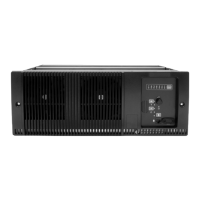14 Replacing the Network Board TB9100 Reciter Service Manual
© Tait Electronics Limited January 2006
■ Power cable, PMU to reciter
■ Ethernet switch or hub (if available)
1.2 Troubleshooting
Before replacing the network board, carry out the following tests on the
reciter to exclude other causes and to verify that the fault actually lies in the
network board hardware.
1. Connect the reciter to the subrack via the I
2
C bus and the DC power
cable. Apply power. This checks whether the digital board is working
and receiving communications from the network board.
a. If no LEDs light on the control panel or rear panel, check that
power is being supplied to the reciter.
b. If the control panel power LED comes on first, followed by the
others, the digital board firmware is working.
c. If the control panel LEDs all remain on for more than 30 seconds,
the digital board is not receiving communications from the net-
work board.
2. Carry out a visual check of the LEDs on the rear of the reciter to
check the network board’s functional subsystems.
a. If all LEDs are off, open the reciter and check the flexible
connector (it supplies power to the network board). Replace if
faulty (see step 5. on page 17).
b. If the PowerPC LED is flashing quickly (2 Hz), the operating sys-
tem kernel is running. If it is flashing slowly (0.5 Hz), only the
bootloader is running. If the Power PC LED does not flash, check
that there is power to the board. The Tx LED should flash once
when power is connected. If it does, power is present, so the boot-
loader must be faulty (see step 7. on page 15).
c. If the orange LED is flashing, the DSP software in the network
board is executing code. If the LED doesn’t flash, open the reciter
and check that the bridge board is connecting properly.
d. The green Ethernet LED should flash if the digital line is con-
nected to an Ethernet switch. This indicates that the digital line is
receiving activity pulse from the Ethernet switch.
3. Connect to the network board’s serial port to test its functioning.
a. Connect your PC to the 9-pin serial connector on the back of the
reciter.
b. Run a program such as HyperTerminal, Teraterm or minicom.
c. Select the following port settings: 57600 baud, 8 bits, no parity, 1
stop bit, no flow control.
d. Press the ‘Enter’ key. If a login prompt appears, the kernel is run-
ning. If the bootloader prompt (=>) appears, contact Tait for

